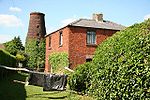
Metheringham Windmill
Encyclopedia

Metheringham
Metheringham is a medium sized village in Lincolnshire approximately ten miles south of the English city of Lincoln...
Flour Mill, was a six-storeyed, six-sailed, and tarred slender Lincolnshire type windmill
Windmill
A windmill is a machine which converts the energy of wind into rotational energy by means of vanes called sails or blades. Originally windmills were developed for milling grain for food production. In the course of history the windmill was adapted to many other industrial uses. An important...
with the typical white onion-shaped cap with fantail
Windmill fantail
A Fantail is a small windmill mounted at right angles to the sails, at the rear of the windmill, and which turns the cap automatically to bring it into the wind. The fantail was patented in 1745 by Edmund Lee, a blacksmith working at Brockmill Forge near Wigan, England, and perfected on mills...
, built in 1867 to be used to grind flour from grain. Located on a paddock
Paddock
A Paddock is an enclosure for horses. It may also refer to: People*Algernon Paddock , American politician*Charlie Paddock , American athlete and actor*Del Paddock , American baseball player...
at the eponymous village in North Kesteven
North Kesteven
North Kesteven is a local government district in the East Midlands. Just over north of London, it is east of Nottingham and south of Lincoln. North Kesteven is one of seven districts in Lincolnshire, England and is in the centre of the County...
south of Lincoln
Lincoln, Lincolnshire
Lincoln is a cathedral city and county town of Lincolnshire, England.The non-metropolitan district of Lincoln has a population of 85,595; the 2001 census gave the entire area of Lincoln a population of 120,779....
it is one of the many tall brick-tower mill
Tower mill
A tower mill is a type of windmill which consists of a brick or stone tower, on top of which sits a roof or cap which can be turned to bring the sails into the wind....
s of Lincolnshire
Lincolnshire
Lincolnshire is a county in the east of England. It borders Norfolk to the south east, Cambridgeshire to the south, Rutland to the south west, Leicestershire and Nottinghamshire to the west, South Yorkshire to the north west, and the East Riding of Yorkshire to the north. It also borders...
with stage, now disused.
The mill was equipped with a complete iron gear, six Sutton patent sails which drove her four pairs of millstone
Millstone
Millstones or mill stones are used in windmills and watermills, including tide mills, for grinding wheat or other grains.The type of stone most suitable for making millstones is a siliceous rock called burrstone , an open-textured, porous but tough, fine-grained sandstone, or a silicified,...
s, and a mill house nearby, but was never prosperous. She later lost up to four of her sails, which were not replaced. The remaining sails were juggled around for balance. Having started with 6 sails, she later ran with four, then two, and finally with three, finishing her sixty years of work around 1930. Until 1942, the mill could be viewed with her unique three sails design and was one of the most photographed mills in the area.
In the following years the remaining sails went, and after 1961 cap and windshaft
Windshaft
The windshaft is a part in a wind mill that carries the sails and also the brake wheel or the head wheel and tail wheel in a Post Mill. Windshafts can be wholly made of wood, or wood with a cast iron poll end or entirely of cast iron....
followed. The tar coating is now wearing off the tower, giving a free view of the unusual banding in her brickwork of 205 courses. Remains of the iron stage can still be found on the mill on the second floor (third floor all in all), but in a bad condition because of the damage done by sail crashes.
There is no public right of access to the mill, so any remains of machinery inside the mill can't be examined.

